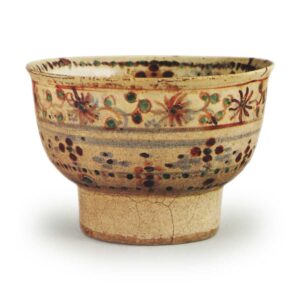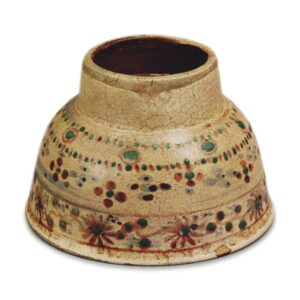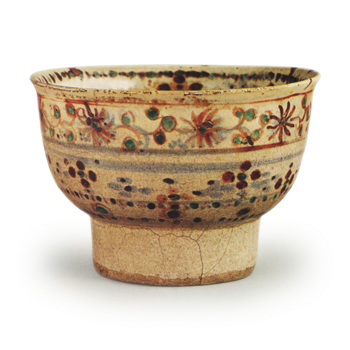

Tokugawa Art Museum
Height: 8.7 – 9.0 cm
Diameter: 12.7 – 13.3 cm
Outer diameter of foot: 6.7 – 7.0 cm
Height: 2.5 cm
When we talk about Anan tea bowls, it seems that the standard is for them to be tie-dye, or dyed, but there are also very rare examples of red-painted ware. This is the most famous of these, and it comes from the Bishu Tokugawa family.
It should probably be called Anan red-painted ware, as opposed to Anan dyed ware, but the old name Beni Anan (Red Anan) is still used today, probably because it sounds good. Judging from the material and the way it was made, it is thought to have been made at the same time and in the same place as the shibori ware.
The clay used for the Tsuchimi is a very white, hard clay that is slightly rare for Annan ware, as it is used for the foot ring around the base of the tea bowl. As it is decorated with colorful overglaze enamels, it is thought that a particularly good clay was chosen for this tea bowl. Perhaps for this reason, this tea bowl is not covered in white slip. The shape is also spacious and carefully made, and the marks of the potter’s wheel have been wiped cleanly away. The foot ring is particularly wide and high, giving the bowl a solid and stable appearance. This foot ring may be a false foot ring, but we cannot be sure. As usual, the inside of the foot ring is covered with a thick coat of iron-oxide slip. As promised, there is a snail-shaped mark on the inside bottom of the bowl, which was made by scraping the glaze off after glazing.
The pattern is first applied as a sketch for the underglaze painting. That is, the lines of the arabesque, Chinese flowers, and patterned bands are drawn in light blue, and then covered with a water glaze and fired. The glaze is a slightly cloudy white with a high feldspar content, and it is covered with cracks all over the surface. The cracks are rough at the bottom and become denser as you move up the surface. This is due to the thickness of the glaze. There are also extra-large cracks running along the bottom of the inside of the bowl.
Now, once the main firing is complete, the colored designs are applied on top of the glaze. There are two colors: red and green, but there are two types of red: a dark red and a light red. Unlike Chinese polychrome ware, it is rare to draw a pattern on top of the underglaze pattern, and it is usually drawn on top of the underglaze pattern. And both the underglaze and polychrome ware are drawn in a childish, rough style, and the firing is not particularly good.
As you can see in the photos, the tone of the underglaze blue and overglaze enamels on the yellowed surface look very amateurish. However, this very amateurishness probably gave the tea bowls a warm, friendly feel that was the opposite of the cool, refined appearance of Chinese overglaze enamels, and this is probably why they were so popular with tea masters of the time.
There are also plum-blossom-shaped Chinese flowers scattered on the inner walls, but what is particularly noteworthy is the fact that the character for “longevity” (寿) is written in red in the center of the snake’s eye. The character for “longevity” is often depicted in Chinese polychrome paintings, so it could be said that this is a copy of that, but it seems to me that it was done in an attempt to win the favor of the tea masters. Along with the shape, which was made to look like a tea bowl, it seems that it was made to order from Japan.



